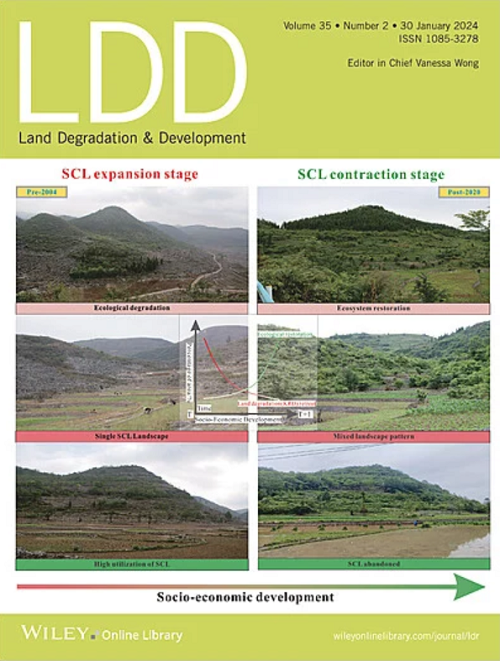Facilitating the Restoration of Disturbed Meadow Soils Using Modified Organic Materials in the Qinghai–Tibet Plateau
IF 3.6
2区 农林科学
Q2 ENVIRONMENTAL SCIENCES
引用次数: 0
Abstract
As host to among the most fragile ecosystems globally, the Qinghai–Tibet Plateau is experiencing considerable ecological degradation. This study investigated the effects of modified organic materials (MOM) on restoring disturbed meadow soils in the Qinghai–Tibet Plateau. The results showed that soil water content decreased with disturbance and was increased through MOM addition by 10.86%, 5.85%, 15.20%, and 90.58% in non-disturbed, lightly disturbed, moderately disturbed, and severely disturbed soil, respectively. The soil acidity significantly increased with disturbance and significantly decreased in severely disturbed soil after restoration. Disturbance increased soil organic carbon (SOC) levels, while MOM application decreased SOC content in lightly (47.74%), moderately (30.53%), and severely disturbed soil (78.55%), but increased it in non-disturbed soil (120.86%). Moreover, activities of enzymes related to the nitrogen and phosphorus cycles decreased with disturbance but increased after restoration. In addition, the microbial communities varied with disturbance. The increase in soil water content and pH following MOM addition increased microbial community abundance. Thus, MOM addition promoted plant growth primarily by enhancing soil water content, reducing soil acidity, and promoting SOC decomposition, which further promoted soil nutrient cycling and improved the microbial community structure.青藏高原是全球生态系统最脆弱的地区之一,正在经历严重的生态退化。本研究调查了改良有机材料(MOM)对恢复青藏高原受干扰草甸土壤的影响。结果表明,土壤含水量随扰动而降低,在未扰动、轻度扰动、中度扰动和严重扰动土壤中,通过添加改性有机材料,土壤含水量分别提高了 10.86%、5.85%、15.20% 和 90.58%。土壤酸度随扰动而明显增加,严重扰动土壤的酸度在恢复后明显降低。扰动增加了土壤有机碳(SOC)含量,而施用 MOM 则降低了轻度扰动土壤(47.74%)、中度扰动土壤(30.53%)和严重扰动土壤(78.55%)的 SOC 含量,但增加了非扰动土壤(120.86%)的 SOC 含量。此外,与氮和磷循环有关的酶的活性随着扰动而降低,但在恢复后却有所提高。此外,微生物群落也随扰动而变化。添加 MOM 后,土壤含水量和 pH 值的增加提高了微生物群落的丰度。因此,添加 MOM 主要是通过提高土壤含水量、降低土壤酸度和促进 SOC 分解来促进植物生长,从而进一步促进土壤养分循环和改善微生物群落结构。
本文章由计算机程序翻译,如有差异,请以英文原文为准。
求助全文
约1分钟内获得全文
求助全文
来源期刊

Land Degradation & Development
农林科学-环境科学
CiteScore
7.70
自引率
8.50%
发文量
379
审稿时长
5.5 months
期刊介绍:
Land Degradation & Development is an international journal which seeks to promote rational study of the recognition, monitoring, control and rehabilitation of degradation in terrestrial environments. The journal focuses on:
- what land degradation is;
- what causes land degradation;
- the impacts of land degradation
- the scale of land degradation;
- the history, current status or future trends of land degradation;
- avoidance, mitigation and control of land degradation;
- remedial actions to rehabilitate or restore degraded land;
- sustainable land management.
 求助内容:
求助内容: 应助结果提醒方式:
应助结果提醒方式:


